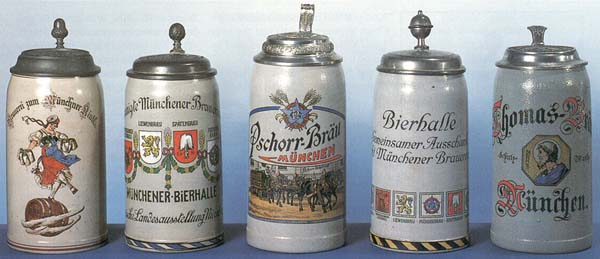
by Johannes Vogt
Translation and additions by Albert Nemeth, M.D.
Since the Middle Ages, beer has been brewed in Munich and consumed out of a variety of drinking vessels. Brewers were organized in guilds. Until the middle of the 19th century, steins and Humpen were exclusively decorated with the emblem of the brewer’s guild. In the 17th and 18th centuries, different factories and small craft shops produced artistically-crafted drinking vessels of faience, glass, and pewter which depicted the emblem of the brewer’s guild (see Figs. 2 center and 3 left, center and right).
Advertising Tools
During the course of the 19th century, the strict rules governing the guilds were broken and replaced in 1868 by trade regulations. The age of competitive trade was born and the different breweries, to increase their sales, had to distinguish themselves from one another through appropriate advertising measures. At this time the beer stein as an advertising medium was discovered. Beginning in the 1870s, Munich breweries had pewter lids manufactured containing their monograms. The lids were mounted on Keferloh Mass (pronounced Kay-fur-low M-ah-s) steins, which were typically one liter, as was customary from the beginning of the 19th century. (One liter is still the quantity dispensed at the Oktoberfest to this date!)
 |
The Keferloh Mass stein, which consists of grey Westerwald stoneware, derives its name from the town of Keferloh (near Munich), where beer was dispensed into these steins during the horse markets held there.
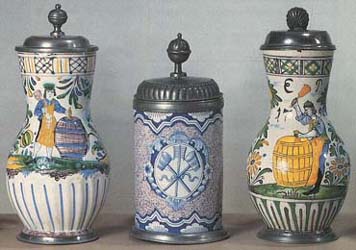 |
Shortly before the turn of the century, the Munich breweries began to label their Mass steins with their individual inscriptions. Initially, berwery inscriptions were hand-engraved into the stein (see Figure 4, left). Somewhat later, it was affixed with a stamp, with either block or script lettering. The brewery inscription was then painted blue and fired in a kiln.
The Turn of the Century
At the turn of the last century, about 1900 beer pubs existed in Munich, along with 28 breweries, whose names are listed in the following table:
| | |
| Augustiner-Bräu | Münchner Bierwürze-Gesellschaft |
| Berg-Brauerei | Munchner Kindl-Bräu |
| Bürgerbräu | Paulaner-Bräu |
| Eberl-Bräu | Pschorrbräu |
| Franziskaner-Leistbräu | Schramm M. Brauerei |
| Gernerbräu | Schwabingerbräu |
| Hackerbräu | Spatenbräu |
| Kloster-Brauerei | Sternecker Bräu |
| Kockelbräu | Thomasbräu |
| Königliches Hofbräuhaus | Unions-Bräu |
| Lehr-und Versuchsanstalt für Brauer | Wagnerbräu |
| Löwenbräu | Weizenbierbrauerei Schneider G. und Sohn |
| Mathäser-Bräu | Weizenbierbrauerei Thalkirchen |
| Michel's Braulehranstalt München | Zacherl-Bräu |
About 1900, the Munich breweries listed above reached a beer production of approximately 3,500,000 hectoliters (about 92.5 million gallons), of which over 1.5 million hectoliters (about 39.5 million gallons) were exported. The average annual per capita beer consumption in Munich at the time was 240 liters (about 254 quarts).
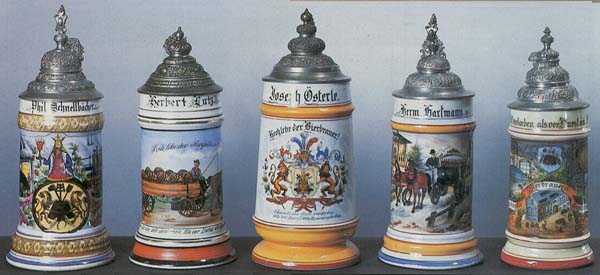 |
Individual Emblems
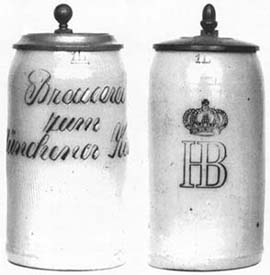 |
Elfenbein Stoneware
Elfenbein (ivory) stoneware is coated with a clear glaze mixture and high-fired to fine stoneware. During the firing in the kiln, it receives its yellowish coloring reminiscent of ivory (thus the name). These steins had a smooth surface which was well-suited for the print-over-glaze (POG) technique. Using the POG technique, the outlines of the motifs were affixed to the yellowish steins with a machine. Then the decoration was hand-painted and fired again. The motif thus consisted of a combination of POG and hand-painting. A variation on the process was to stamp the brewery emblems and script signatures onto the steins and only handpaint the beginning letters (see Fig. 5, right).
Fine Stoneware
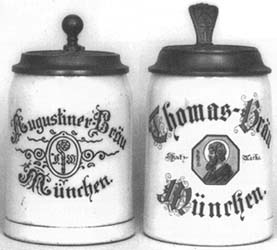 |
Pressed Glass Steins
Since the turn of the century, in addition to stoneware steins, the Munich breweries also had pressed glass steins made for them by the Sachsen Glass Company in Ottendorf-Okrilla. These glass steins were mounted with the pewter lids of the respective brewery. In some instances, they also had the brewery name on the bottom inside of the stein so that the name of the respective brewery could be read after emptying the stein. Pressed glass steins were produced in quarter- and half-liter sizes.
The Munich firm of Martin Pauson, founded in 1884, sold special order steins and pewter lids in limited editions. An example is the one-liter stein with the inscription Vereinigte Münchener Brauereien (Union of Munich Breweries) ca. 1910. This union was a voluntary alliance of local breweries and thus a sort of successor to the former brewer’s guild.
In addition to the firms already mentioned, Reinhold Merkelbach and Martin Pauson, the Munich breweries also had their steins produced by the following: Vitus Herr, Munich; L. Thannemann and Cie, Munich; Villeroy & Boch, Mettlach; Marzi & Remy, Grenzhausen; and Merkelbach & Wick, Grenzhausen.
The pewter lids for the brewery steins were made in Munich by a variety of pewter foundries: A. Schneider; Brüder Thannhauser Zinngusswarenfabrik; Ch. Reck; Ludwig Mory; Martin Pauson; and Pruckners Nachfolger.
__________
*Reprinted from The Beer Stein Journal, November 1994, by permission from Gary Kirsner Auctions.